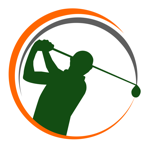dorset golf
How does the Wind Effect Your Golf Shots?
22/12/18 11:26
Even though Poole is blessed with more than its fair share of sunny weather compared to many areas of the British Isles, because it is located by the coast, the courses in the area are sometimes exposed to what many golfers would describe as particularly windy conditions. For the uninitiated these can be particularly difficult to handle so here are a few facts and tips that can help you handle the wind.
Headwind and Tailwind
The following table shows you how much a headwind or tailwind can affect your carry distance. I have used an amateur golfer who swings a 6 iron at 80 mph in this example which normally leads him to carrying the ball 153 yards when there is no wind.

As you can see, a headwind hurts more than a tailwind helps. It is worth noting that headwinds and tail winds also affect the height and land angle of a golf shot. When hitting into a headwind shots will fly higher and land steeper and a tailwind produces shots that fly lower and land flatter. Contrary to popular belief, the wind does not have an effect on the spin rate of the golf shot but into a head wind, spin is the enemy as it increases lift and drag. Swinging harder creates more club head speed which creates more spin. To counter this you should use a club with less loft as this will reduce the spin loft and therefore the spin rate. If you want to take maximum advantage of a tail wind, make sure you use a club that enables you to launch the ball higher as otherwise the ball will fall to the ground too soon.
Headwind Driver Tip: You may have heard of high launch and low spin to maximise distance? Theoretically, when hitting a driver into a headwind you will still benefit from doing this unless the wind speed is above 30mph. However, the longer the ball is in the air the more the ball can be affected by the wind. This means that if you sometimes have difficulties hitting the ball down the middle you may benefit from launching the ball lower and relying on more roll to get the ball to travel the expected distance.
Crosswinds
The following table shows you how far offline the ball will travel when hitting into crosswinds. Again I have used an amateur golfer who is swinging a 6 iron at 80 miles per hour.

As you can see, a 20 mph crosswind will send a straight shot 81 feet to the side, that is a full 27 yards to the side! Make sure you are aware of this so you can sufficiently allow for it when you are next on the course.
Many people are often shocked when they find out quite how much the wind can affect a golf shot, make sure you don’t let it surprise you.
Headwind and Tailwind
The following table shows you how much a headwind or tailwind can affect your carry distance. I have used an amateur golfer who swings a 6 iron at 80 mph in this example which normally leads him to carrying the ball 153 yards when there is no wind.

As you can see, a headwind hurts more than a tailwind helps. It is worth noting that headwinds and tail winds also affect the height and land angle of a golf shot. When hitting into a headwind shots will fly higher and land steeper and a tailwind produces shots that fly lower and land flatter. Contrary to popular belief, the wind does not have an effect on the spin rate of the golf shot but into a head wind, spin is the enemy as it increases lift and drag. Swinging harder creates more club head speed which creates more spin. To counter this you should use a club with less loft as this will reduce the spin loft and therefore the spin rate. If you want to take maximum advantage of a tail wind, make sure you use a club that enables you to launch the ball higher as otherwise the ball will fall to the ground too soon.
Headwind Driver Tip: You may have heard of high launch and low spin to maximise distance? Theoretically, when hitting a driver into a headwind you will still benefit from doing this unless the wind speed is above 30mph. However, the longer the ball is in the air the more the ball can be affected by the wind. This means that if you sometimes have difficulties hitting the ball down the middle you may benefit from launching the ball lower and relying on more roll to get the ball to travel the expected distance.
Crosswinds
The following table shows you how far offline the ball will travel when hitting into crosswinds. Again I have used an amateur golfer who is swinging a 6 iron at 80 miles per hour.

As you can see, a 20 mph crosswind will send a straight shot 81 feet to the side, that is a full 27 yards to the side! Make sure you are aware of this so you can sufficiently allow for it when you are next on the course.
Many people are often shocked when they find out quite how much the wind can affect a golf shot, make sure you don’t let it surprise you.
Back Straight and Chin Up?
20/12/18 15:22
The Myth:
Is is often said golfers should setup with a straight back and neck. Two reasons often given for this are that it is athletic and allows room for the lead shoulder to turn under the chin during the backswing.
Reality:
Your torso should be flexed forwards towards the ground but the back should not be straight. While the spine should be relatively straight at the bottom it should flex forwards progressively more as you reach the top.
This will tilt your head downward so you are able to see the ball without straining to see it by looking out of the bottom of your eyes. The benefit of seeing the ball in this way, through your central vision, is that your brain will be able to process the image in more detail. If the eyes keep having to relocate the ball this leads to difficulties perceiving depth and thus makes it hard for the brain to compute where the ball is. The result of this are all kinds of compensations made on the fly, not the best way to play an already difficult game.
This curvature of the upper spine will also make it much easier for you to turn your shoulders in a circle without losing your inclination to the ground as the lead shoulder will be in position to travel downwards and back rather than just back, thus nullifying the room to turn the shoulder under the chin hypothesis.
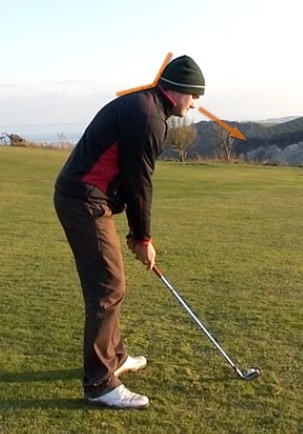
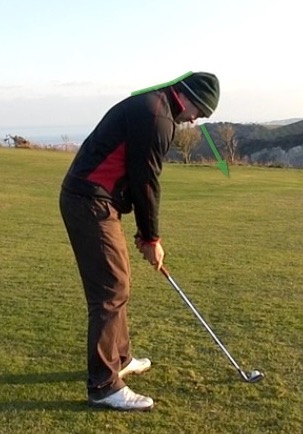
NO on the left
Depth Perception and ability to maintain inclination to ground compromised
YES on the right
Lower spine relatively straight and top of the spine curving progressively more towards the ball
I would encourage you to find videos on YouTube of some of the greats such as Sam Snead, Jack Nicklaus or Arnold Palmer and you will see they all exhibit these traits.
Is is often said golfers should setup with a straight back and neck. Two reasons often given for this are that it is athletic and allows room for the lead shoulder to turn under the chin during the backswing.
Reality:
Your torso should be flexed forwards towards the ground but the back should not be straight. While the spine should be relatively straight at the bottom it should flex forwards progressively more as you reach the top.
This will tilt your head downward so you are able to see the ball without straining to see it by looking out of the bottom of your eyes. The benefit of seeing the ball in this way, through your central vision, is that your brain will be able to process the image in more detail. If the eyes keep having to relocate the ball this leads to difficulties perceiving depth and thus makes it hard for the brain to compute where the ball is. The result of this are all kinds of compensations made on the fly, not the best way to play an already difficult game.
This curvature of the upper spine will also make it much easier for you to turn your shoulders in a circle without losing your inclination to the ground as the lead shoulder will be in position to travel downwards and back rather than just back, thus nullifying the room to turn the shoulder under the chin hypothesis.

NO on the left
Depth Perception and ability to maintain inclination to ground compromised
YES on the right
Lower spine relatively straight and top of the spine curving progressively more towards the ball
I would encourage you to find videos on YouTube of some of the greats such as Sam Snead, Jack Nicklaus or Arnold Palmer and you will see they all exhibit these traits.
It's all about Impact
20/12/18 15:19
This is an often used refrain that carries a lot of truth. Even though impact with the golf ball lasts only 1/2000 of a second, it will determine in large part what happens to your shot. The club’s direction of travel, where the face points and the speed at which the club travels are all important, but none more so than where on the club face you make contact. When the strike point is off centre then all bets are off.
Did you know that if you strike the ball towards the heel of the club this causes the ball to fade or draw less and if you hit the ball towards the toe of the club it causes the ball to draw or fade less? This is especially the case with the driver and is why they are not built with a flat surface.
Did you know that if you hit the ball towards the bottom of your driver face then your ball speed will go down by almost as much as 10 miles per hour and the spin rate will increase by almost 800rpm?
All this is caused by a phenomenon called gear effect and it happens on virtually every single golf shot that is hit. This is because even the best golfers miss the sweet spot more often than they find it. With that being said, it is also true that most golfers tend to have a specific pattern of where they hit the ball on the club face.
If you would like to find out where your contact point is I recommend you bring to the course a bottle of dry shampoo or any spray that doesn’t leave a permanent mark, spray it on your club face, hit some shots and see where the marks are left.
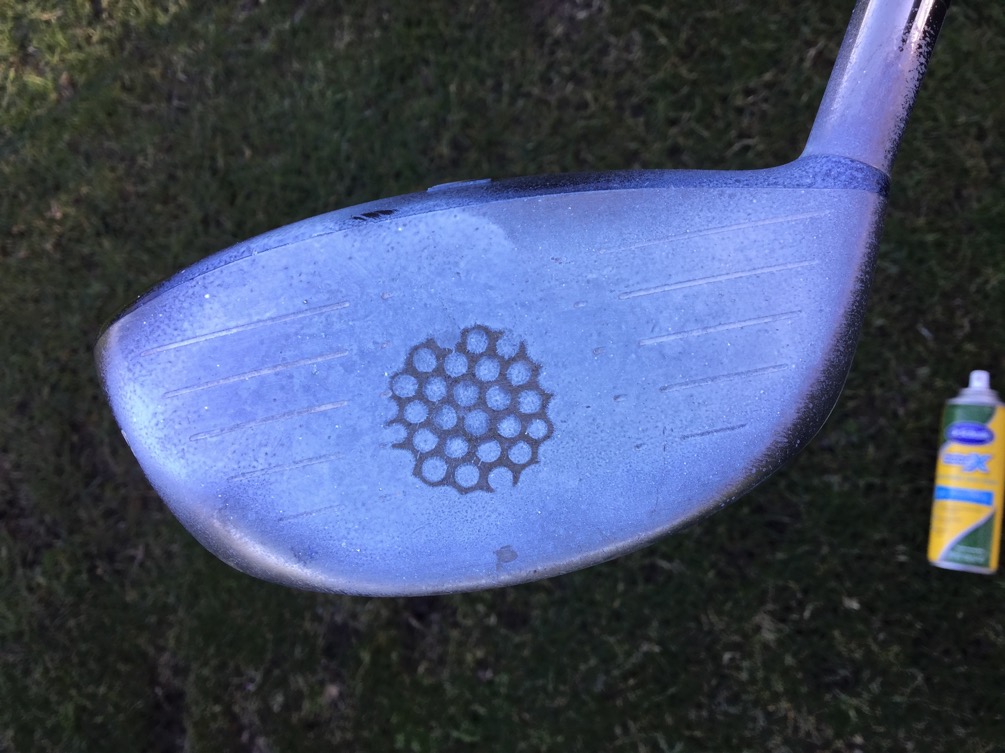
If you create an awareness of what your strike pattern is you will then be able to embark on the journey towards improving it.
Remember, if you are after more distance, it is more important to learn to hit the ball on the middle of the club face than it is to learn to swing the club faster.
Note of Caution: For those of you who have access to a Trackman when you practice, quality of strike is sometimes correlated to the Smash Factor number. Please be aware that there are instances when you cannot reach the elusive 1.5 smash factor number with a driver even with a perfect strike. This would happen, for example, when you hit down on the driver and your spin loft needs to be high enough for the ball to stay in the air longer.
Did you know that if you strike the ball towards the heel of the club this causes the ball to fade or draw less and if you hit the ball towards the toe of the club it causes the ball to draw or fade less? This is especially the case with the driver and is why they are not built with a flat surface.
Did you know that if you hit the ball towards the bottom of your driver face then your ball speed will go down by almost as much as 10 miles per hour and the spin rate will increase by almost 800rpm?
All this is caused by a phenomenon called gear effect and it happens on virtually every single golf shot that is hit. This is because even the best golfers miss the sweet spot more often than they find it. With that being said, it is also true that most golfers tend to have a specific pattern of where they hit the ball on the club face.
If you would like to find out where your contact point is I recommend you bring to the course a bottle of dry shampoo or any spray that doesn’t leave a permanent mark, spray it on your club face, hit some shots and see where the marks are left.
If you create an awareness of what your strike pattern is you will then be able to embark on the journey towards improving it.
Remember, if you are after more distance, it is more important to learn to hit the ball on the middle of the club face than it is to learn to swing the club faster.
Note of Caution: For those of you who have access to a Trackman when you practice, quality of strike is sometimes correlated to the Smash Factor number. Please be aware that there are instances when you cannot reach the elusive 1.5 smash factor number with a driver even with a perfect strike. This would happen, for example, when you hit down on the driver and your spin loft needs to be high enough for the ball to stay in the air longer.
Which Golfer Hit a Draw
20/12/18 15:05
Can you make an educated guess? In which of these two pictures did the golfer play a draw?
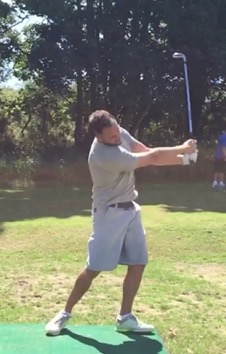
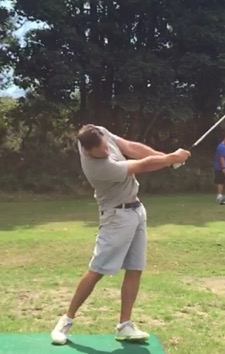
A on the left B on the right
These two shots are taken from a recent golf lesson where the pupil was struggling to hit draws and instead hitting shots that started and curved too far to the right.
You were correct if you answered picture B. Hopefully you weren’t fooled by the rolling of the forearms that can be seen in picture A as this look is sometimes incorrectly associated with hitting a draw. The tell tale signs of a draw to look out for in the right picture include the following:
The belt buckle is moving upwards more (notice the straighter legs)
The spine is extending more (notice the chest points to the sky) The re-hinging of the wrists is slower (notice the club shaft isn’t perpendicular to the ground)
You can see the numbers for the two shots below, a 25 yard deflected slice on the left and an 8 yard push-draw on the right.
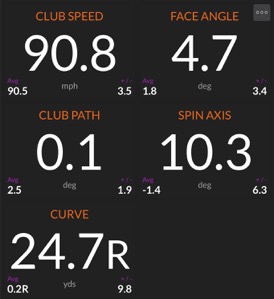

If you know what to look for and upgrade your swing in the right areas, your ball flight, trackman numbers and scores on the course can change dramatically in a very short amount of time.


A on the left B on the right
These two shots are taken from a recent golf lesson where the pupil was struggling to hit draws and instead hitting shots that started and curved too far to the right.
You were correct if you answered picture B. Hopefully you weren’t fooled by the rolling of the forearms that can be seen in picture A as this look is sometimes incorrectly associated with hitting a draw. The tell tale signs of a draw to look out for in the right picture include the following:
The belt buckle is moving upwards more (notice the straighter legs)
The spine is extending more (notice the chest points to the sky) The re-hinging of the wrists is slower (notice the club shaft isn’t perpendicular to the ground)
You can see the numbers for the two shots below, a 25 yard deflected slice on the left and an 8 yard push-draw on the right.


If you know what to look for and upgrade your swing in the right areas, your ball flight, trackman numbers and scores on the course can change dramatically in a very short amount of time.
Avoid Fat Shots and Control Your Low Point
20/12/18 15:02
Are you tired and frustrated of not being able to hit the ball solidly when it rests on the ground?
Are you unable to take a divot and when you do take one it happens to be the big ball (earth) before the little one?
Learning to hit the ball before the ground and learning to hit the same spot on the ground every time with your club are invaluable skills if you wish to bring your handicap down. Thankfully, there is a simple observation that can help you in this regard.
When measuring how the best players move it is noticeable they move their hips towards the target at impact more compared to the less skilled golfers who have their hips further back.
What does this mean for you? It means that if you tend to hit fat shots, there is a good chance you can work on this by having your hips more forwards (towards the target) as you hit the ball.
To work on this, setup with an alignment stick on the ground between your ball and your feet that you put parallel to your intended line. When you make your downswing, focus on trying to slide your hips towards the target along the stick you have placed on the ground. This is a lateral move and not a rotary one. You should feel like you are trying to get your right hip pocket in front of the ball at impact
Expert Golfer Demonstration: Notice the hips slide progressively more towards the target throughout the swing.

Novice Golfer Demonstration: This golfer has the hips further back than the expert golfer and this has negative consequences on their ball striking ability

Are you unable to take a divot and when you do take one it happens to be the big ball (earth) before the little one?
Learning to hit the ball before the ground and learning to hit the same spot on the ground every time with your club are invaluable skills if you wish to bring your handicap down. Thankfully, there is a simple observation that can help you in this regard.
When measuring how the best players move it is noticeable they move their hips towards the target at impact more compared to the less skilled golfers who have their hips further back.
What does this mean for you? It means that if you tend to hit fat shots, there is a good chance you can work on this by having your hips more forwards (towards the target) as you hit the ball.
To work on this, setup with an alignment stick on the ground between your ball and your feet that you put parallel to your intended line. When you make your downswing, focus on trying to slide your hips towards the target along the stick you have placed on the ground. This is a lateral move and not a rotary one. You should feel like you are trying to get your right hip pocket in front of the ball at impact
Expert Golfer Demonstration: Notice the hips slide progressively more towards the target throughout the swing.

Novice Golfer Demonstration: This golfer has the hips further back than the expert golfer and this has negative consequences on their ball striking ability
Five Tips to Stop Swinging Across
20/12/18 14:56
If you struggle with slices, pulls, short clubs that fly too high and long clubs that fly too low or a general lack of distance there is a good chance you suffer from this fault. These are shots that for a right handed golfer fly to the left and stay to the left left or shots that curve excessively to the right. Swinging across the ball is commonly known as swinging from out/in. For right handed players, it means your club head is moving to the left of the target as you strike the ball.
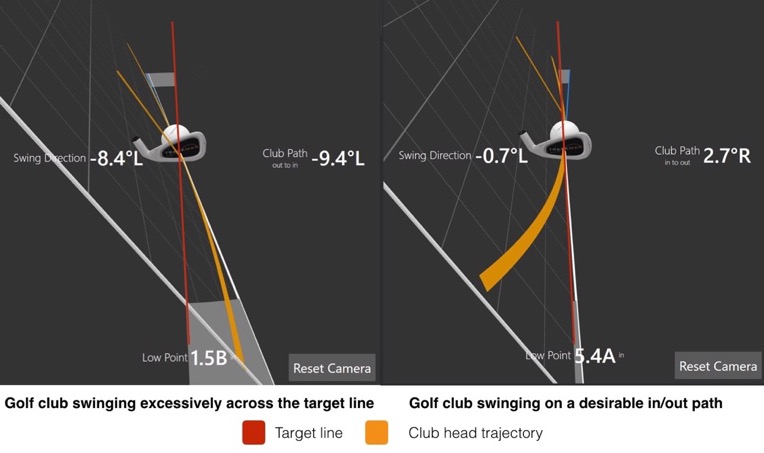
Here are 5 tips you can follow to correct this issue:
1. Weight location
Your weight should be forwards as you strike the ball. Often golfers will have too much weight back at address, move it back during the backswing, during the follow though or a combination of all these. Your hips must shift forwards during your downswing. It is common knowledge that the hips must turn but there must also be an element of lateral slide. If the hips turn but don’t slide, your club will begin to swing across the ball.
2. Handle location
When the handle leans away from the target at impact the club head will swing across the ball. You do not want to deliberately attempt to roll the wrists through impact. Instead focus on keeping the distance between your elbows constant throughout your swing as this will enable you to hit the ball with your handle leaning towards the target
3. Hand Path
The hands should work backwards, upwards and inwards during the course of the backswing. Golfers who swing across the ball often don’t move the hands sufficiently inwards and instead lift the arms off the ribcage in an upward motion.
4. Lead Knee Action
Make sure you don’t straighten your lead knee too soon during your downswing as this throws the hips back and spins them open. Straightening the knee is a power move but should not start to happen until the club shaft is parallel to the ground during the backswing. The lead knee should not be straight until your arms are parallel to the ground during the follow through.
5. Ball Position
Move the ball slightly back in your stance so you make contact with the ball earlier on the club head’s arc through the ball
Play well and I look forward to your feedback when you try these 5 tips.

Here are 5 tips you can follow to correct this issue:
1. Weight location
Your weight should be forwards as you strike the ball. Often golfers will have too much weight back at address, move it back during the backswing, during the follow though or a combination of all these. Your hips must shift forwards during your downswing. It is common knowledge that the hips must turn but there must also be an element of lateral slide. If the hips turn but don’t slide, your club will begin to swing across the ball.
2. Handle location
When the handle leans away from the target at impact the club head will swing across the ball. You do not want to deliberately attempt to roll the wrists through impact. Instead focus on keeping the distance between your elbows constant throughout your swing as this will enable you to hit the ball with your handle leaning towards the target
3. Hand Path
The hands should work backwards, upwards and inwards during the course of the backswing. Golfers who swing across the ball often don’t move the hands sufficiently inwards and instead lift the arms off the ribcage in an upward motion.
4. Lead Knee Action
Make sure you don’t straighten your lead knee too soon during your downswing as this throws the hips back and spins them open. Straightening the knee is a power move but should not start to happen until the club shaft is parallel to the ground during the backswing. The lead knee should not be straight until your arms are parallel to the ground during the follow through.
5. Ball Position
Move the ball slightly back in your stance so you make contact with the ball earlier on the club head’s arc through the ball
Play well and I look forward to your feedback when you try these 5 tips.
Elite Player Benchmarking with Trackman
12/08/17 13:14
Elite Player Benchmarking & Practice with Trackman
One of the benefits of training with Trackman is the feedback both the player and coach receive with regards to the ball flight and club data. Being able to demonstrate progress and the effect of different moves on the numbers is invaluable for the coach. Being able to create a feel for the swing when a certain set of numbers is created is invaluable for the player as having quality feedback invariably speeds up the learning process. Another benefit is the ability to create meaningful practice scenarios via the Trackman Test Centre and to use these to benchmark players’ ability. In this article I will share two of the exercises I use with elite golfers but first let’s look at some of the aspects that must be present in order to make the most of your practice sessions.
How to make your practice count?
It is important to practice with a purpose and for there to be a consequence to the shots you hit while training. There are countless examples of golfers who spend hour after hour on the driving range hitting shot after shot and who in the long run achieve very little other than perhaps the ability to hit nice looking shots on the driving range. This is largely due to the fact they are hitting golf shots out of context as there is no reward or penalty for good and bad shots, there is always the opportunity to hit one more shot. Driving ranges also tend to be fairly wide making it difficult to evaluate the true worth of each shot. Perhaps the only shot that has real consequence when people practice on the range is the one with the last ball in the range basket. If you hit that shot badly the session ends on a disappointing note and if you hit it well you go home thinking all is well and your game is in shape. In fact, I often see golfers get around this problem by actually stopping their practice sessions a few balls shy of the last ball in the basket. A good shot is hit, there are three balls left in the basket and the golfer doesn’t bother to hit the last three as he wants to finish with a good one. Try not to be guilty of this as sadly, this is not how it works when you are out on the golf course, there are no second serves and every shot counts. You want to try and replicate the pressure you feel on the first tee on all the shots you hit during your practice. It is important to try and make practice simulate the real game as closely as possible, perhaps even at times making it harder than the game itself. It is also important for you to be able to quantify your practice in terms of your performance and not simply in terms of the time spent hitting balls. Practice with all these things in mind and you will maximise your chances of improving.
- MAKE IT MEASURABLE (OBJECTIVE NOT SUBJECTIVE) - MAKE IT REAL (CONSEQUENCE AND PRESSURE) - MAKE IT HARD
Test Centre assessments for elite players
As I said earlier, there are many benefits to Trackman, not simply to do with the quality of the data but to do with the actual method of training and the ability to monitor results. No doubt most people who regularly work with a Trackman unit have at some stage carried out a combine test. The Combine is a standardised test asking golfers to hit 60 shots at 10 different targets and gives all shots a score out of 100. Because of the sheer number of people who have taken the test it allows comparisons to be made between golfers of different abilities. If you’ve ever taken this test you will know the pressure that is created by knowing that your score will be posted on a worldwide leaderboard for your friends and
everyone to see. The Test feature on the software also allows specific tests to be designed.
The following are two tests/games I carry out with elite and aspiring players 1. Beat the Pro
This first test is based on the information gathered by shotlink on the PGA Tour and the work done by Mark Broadie that he discusses in detail in his book “Every Shot Counts”. In the book, he lists the average proximity to the hole from a number of distances and a number of lies for both the very best pro and the average pro on the PGA Tour. I have collated this data in the table below.
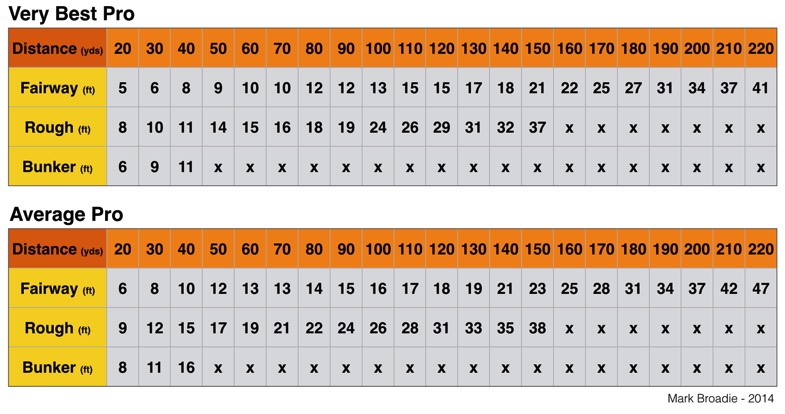
A good time to carry out this test is when you have established a particular distance that you wish to improve. This could for example be following a Combine Test where you have determined that your weakest distances are 90 yards and 180 yards or following a round of golf where you hit some errant shots that you didn’t like from specific distances.
The object of the game is to hit 9 shots from your selected distance and establish whether you can beat the average PGA Tour Pro or even the very best PGA Tour Pro. You receive 1 point for beating the average pro and 2 points if you beat the best pro. This means that the game is scored out of 18 points in total. You must change the target every three shots in order for the shots not to become too repetitive and simulate golf as closely as possible. As an example, you have decided that 140 yards is a weakness. Create a Trackman test with 9 shots at 140 yards. Select a target and hit the first three shots. If your ball finishes between 21 and 19 feet from the pin you receive one point and if it finishes 18 feet or closer to the pin you receive 2 points. After the first three shots change the target and repeat. Tally up the score at the end out of 18 to establish your result for that session.
You are only allowed to carry out the test at each distance once per practice session. Remember there are no second serves in golf and you want to carry out the test in a pressured environment. If you could simply take it again after an unsatisfactory result that would be too easy. There is nothing better than simulating pressure if you want to perform well under pressure when you’re competing. I would urge you to keep a record of your results and to write them down in a little notebook, there is nothing quite like putting pen to paper. Notice you can also carry out this test from the rough and to benchmark yourself on bunker shots up to 40 yards.
2. Race to Number One
This second test is based on the info gathered by Shot link on the PGA Tour and the stats that are kept on pgatour.com in the accuracy from fairway section. These stats list the average proximity to the hole for all PGA Tour players from between set distances. In 2016 for example, from 50-75 yards Hunter Mahan lead the tour by finishing just 8’11” from the hole when playing shots from the fairway from that range. This is a test you can also carry out with aspiring elite players in order to establish which areas might need improvement and the gap that must be filled between their performance and that of a PGA Tour player.
The yardages the PGA Tour keep statistics for are: 50-75 yards / 75-100 yards / 100-125 yards / 125-150 yards / 150-175 yards / 175-200 yards / 200-225 yards / 225-250 yards / 250-275 yards
The Tour also keeps statistics for wider windows such as 50-125 yards but I don’t tend to use these as the data could be biased if you were doing a Random Test depending on whether Trackman gave you more shorter or more longer shots.
Carrying out this test involves hitting 10 shots and establishing your average distance from the pin from the range you have selected. Let’s set it up as though you were working on 125 to 150 yards. Create a Random Test on Trackman setting the lower distance as 125 and the upper distance as 150 yards, select 10 shots. Select your target and hit two shots at the required distance towards that target. Every couple of shots you must aim the Trackman at a different target. Carry on until you have hit all 10 shots. Once you have finished check the Report and see what your average distance from the pin is and compare it to the players on the PGA Tour.
The following is a test report after conducting a 125-150 yards test. This player’s result is circled in red and indicates, using the “Approaches to the Green” table below, he is 1’1” outside 150th place on the PGA Tour from that range meaning there is some work to be done in this area.
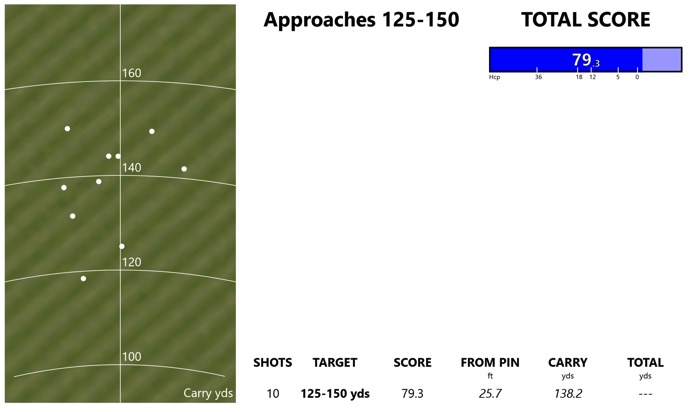
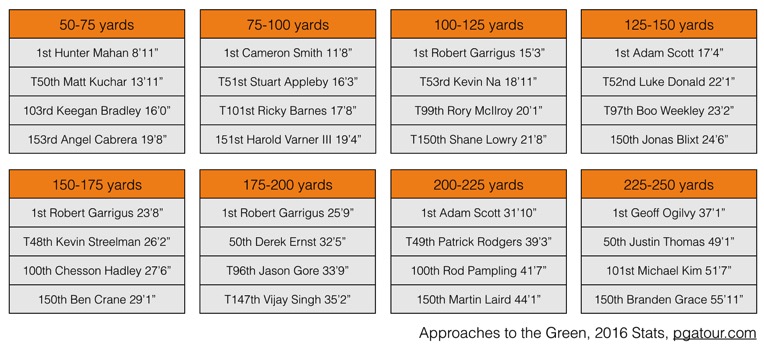
If you visit the PGA Tour website you will notice that average distances are also worked out for shots hit from the rough. This means that just like the first test, you could also carry out this second test from the rough. If you want to further increase the difficulty of this test you can play shots with the ball resting on uneven lies (above, below, uphill, downhill), just make sure you don’t pay too much attention to the club data when you do this.
It is important to note that Trackman’s distance from the pin measurement is based on where the ball landed using carry flat. It’s very much like throwing darts, Trackman is asking can you land it as close as possible to your target? The statistics from the Tour, however, are taken from shots hit on the golf course and this means that the players have to take into account how the ball is going to respond when it lands. It also means that at times the golfers may not be aiming straight at the flag. Nonetheless, these two exercises provide you with some very real targets to beat and measure yourself against.
Remember, it is important for you to simulate real golf as closely as possible when practicing. You need to feel a sense of pressure otherwise you will not be able to replicate your new skills when you are out on the golf course. Every shot needs to have a purpose and every shot must count. When possible, your practice should be harder than the real thing. These two tests will allow you to gauge your current ability and help you and your coach structure your practice.
Please let me know how you get on, I look forward to hearing your results.
One of the benefits of training with Trackman is the feedback both the player and coach receive with regards to the ball flight and club data. Being able to demonstrate progress and the effect of different moves on the numbers is invaluable for the coach. Being able to create a feel for the swing when a certain set of numbers is created is invaluable for the player as having quality feedback invariably speeds up the learning process. Another benefit is the ability to create meaningful practice scenarios via the Trackman Test Centre and to use these to benchmark players’ ability. In this article I will share two of the exercises I use with elite golfers but first let’s look at some of the aspects that must be present in order to make the most of your practice sessions.
How to make your practice count?
It is important to practice with a purpose and for there to be a consequence to the shots you hit while training. There are countless examples of golfers who spend hour after hour on the driving range hitting shot after shot and who in the long run achieve very little other than perhaps the ability to hit nice looking shots on the driving range. This is largely due to the fact they are hitting golf shots out of context as there is no reward or penalty for good and bad shots, there is always the opportunity to hit one more shot. Driving ranges also tend to be fairly wide making it difficult to evaluate the true worth of each shot. Perhaps the only shot that has real consequence when people practice on the range is the one with the last ball in the range basket. If you hit that shot badly the session ends on a disappointing note and if you hit it well you go home thinking all is well and your game is in shape. In fact, I often see golfers get around this problem by actually stopping their practice sessions a few balls shy of the last ball in the basket. A good shot is hit, there are three balls left in the basket and the golfer doesn’t bother to hit the last three as he wants to finish with a good one. Try not to be guilty of this as sadly, this is not how it works when you are out on the golf course, there are no second serves and every shot counts. You want to try and replicate the pressure you feel on the first tee on all the shots you hit during your practice. It is important to try and make practice simulate the real game as closely as possible, perhaps even at times making it harder than the game itself. It is also important for you to be able to quantify your practice in terms of your performance and not simply in terms of the time spent hitting balls. Practice with all these things in mind and you will maximise your chances of improving.
- MAKE IT MEASURABLE (OBJECTIVE NOT SUBJECTIVE) - MAKE IT REAL (CONSEQUENCE AND PRESSURE) - MAKE IT HARD
Test Centre assessments for elite players
As I said earlier, there are many benefits to Trackman, not simply to do with the quality of the data but to do with the actual method of training and the ability to monitor results. No doubt most people who regularly work with a Trackman unit have at some stage carried out a combine test. The Combine is a standardised test asking golfers to hit 60 shots at 10 different targets and gives all shots a score out of 100. Because of the sheer number of people who have taken the test it allows comparisons to be made between golfers of different abilities. If you’ve ever taken this test you will know the pressure that is created by knowing that your score will be posted on a worldwide leaderboard for your friends and
everyone to see. The Test feature on the software also allows specific tests to be designed.
The following are two tests/games I carry out with elite and aspiring players 1. Beat the Pro
This first test is based on the information gathered by shotlink on the PGA Tour and the work done by Mark Broadie that he discusses in detail in his book “Every Shot Counts”. In the book, he lists the average proximity to the hole from a number of distances and a number of lies for both the very best pro and the average pro on the PGA Tour. I have collated this data in the table below.

A good time to carry out this test is when you have established a particular distance that you wish to improve. This could for example be following a Combine Test where you have determined that your weakest distances are 90 yards and 180 yards or following a round of golf where you hit some errant shots that you didn’t like from specific distances.
The object of the game is to hit 9 shots from your selected distance and establish whether you can beat the average PGA Tour Pro or even the very best PGA Tour Pro. You receive 1 point for beating the average pro and 2 points if you beat the best pro. This means that the game is scored out of 18 points in total. You must change the target every three shots in order for the shots not to become too repetitive and simulate golf as closely as possible. As an example, you have decided that 140 yards is a weakness. Create a Trackman test with 9 shots at 140 yards. Select a target and hit the first three shots. If your ball finishes between 21 and 19 feet from the pin you receive one point and if it finishes 18 feet or closer to the pin you receive 2 points. After the first three shots change the target and repeat. Tally up the score at the end out of 18 to establish your result for that session.
You are only allowed to carry out the test at each distance once per practice session. Remember there are no second serves in golf and you want to carry out the test in a pressured environment. If you could simply take it again after an unsatisfactory result that would be too easy. There is nothing better than simulating pressure if you want to perform well under pressure when you’re competing. I would urge you to keep a record of your results and to write them down in a little notebook, there is nothing quite like putting pen to paper. Notice you can also carry out this test from the rough and to benchmark yourself on bunker shots up to 40 yards.
2. Race to Number One
This second test is based on the info gathered by Shot link on the PGA Tour and the stats that are kept on pgatour.com in the accuracy from fairway section. These stats list the average proximity to the hole for all PGA Tour players from between set distances. In 2016 for example, from 50-75 yards Hunter Mahan lead the tour by finishing just 8’11” from the hole when playing shots from the fairway from that range. This is a test you can also carry out with aspiring elite players in order to establish which areas might need improvement and the gap that must be filled between their performance and that of a PGA Tour player.
The yardages the PGA Tour keep statistics for are: 50-75 yards / 75-100 yards / 100-125 yards / 125-150 yards / 150-175 yards / 175-200 yards / 200-225 yards / 225-250 yards / 250-275 yards
The Tour also keeps statistics for wider windows such as 50-125 yards but I don’t tend to use these as the data could be biased if you were doing a Random Test depending on whether Trackman gave you more shorter or more longer shots.
Carrying out this test involves hitting 10 shots and establishing your average distance from the pin from the range you have selected. Let’s set it up as though you were working on 125 to 150 yards. Create a Random Test on Trackman setting the lower distance as 125 and the upper distance as 150 yards, select 10 shots. Select your target and hit two shots at the required distance towards that target. Every couple of shots you must aim the Trackman at a different target. Carry on until you have hit all 10 shots. Once you have finished check the Report and see what your average distance from the pin is and compare it to the players on the PGA Tour.
The following is a test report after conducting a 125-150 yards test. This player’s result is circled in red and indicates, using the “Approaches to the Green” table below, he is 1’1” outside 150th place on the PGA Tour from that range meaning there is some work to be done in this area.


If you visit the PGA Tour website you will notice that average distances are also worked out for shots hit from the rough. This means that just like the first test, you could also carry out this second test from the rough. If you want to further increase the difficulty of this test you can play shots with the ball resting on uneven lies (above, below, uphill, downhill), just make sure you don’t pay too much attention to the club data when you do this.
It is important to note that Trackman’s distance from the pin measurement is based on where the ball landed using carry flat. It’s very much like throwing darts, Trackman is asking can you land it as close as possible to your target? The statistics from the Tour, however, are taken from shots hit on the golf course and this means that the players have to take into account how the ball is going to respond when it lands. It also means that at times the golfers may not be aiming straight at the flag. Nonetheless, these two exercises provide you with some very real targets to beat and measure yourself against.
Remember, it is important for you to simulate real golf as closely as possible when practicing. You need to feel a sense of pressure otherwise you will not be able to replicate your new skills when you are out on the golf course. Every shot needs to have a purpose and every shot must count. When possible, your practice should be harder than the real thing. These two tests will allow you to gauge your current ability and help you and your coach structure your practice.
Please let me know how you get on, I look forward to hearing your results.
The Low Point, DIfferent Skill Levels and its Mastery
12/08/17 12:11
THE LOW POINT, DIFFERENT SKILL LEVELS AND ITS MASTERY Low Point - Definition
Trackman measures a number called Low Point and learning to master the Low Point is an essential skill for golfers who want to make good contact with the ball and maximise their distance. The technical definition is that the Low Point represents the distance from the club head’s geometric centre to the lowest point on the swing arc at the time of maximum compression. Impact can occur either before the Low Point or after the Low Point has been reached by the club head. There is a strong correlation between Angle of Attack and Low Point as when the golfer hits down on the golf ball the Low Point is situated after the golf ball and when the golfer hits up on the golf ball the Low Point is situated before the golf ball. The illustrations below help to provide a clear understanding of the concept.
Low Point Illustration
The following picture depicts the arc the club head travels from approximately knee height on the downswing to knee height on the through swing with the bottom of the arc depicted here by a vertical white line. The lowest point on this arc is what is termed the Low Point. The ball is struck either before the club head reaches the low point with a descending angle of attack or after the club head reaches the low point with an upwards angle of attack.
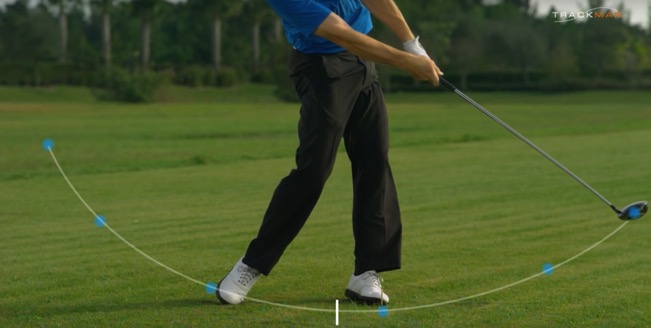
In the picture below, you can see an example of the Low Point situated just after the golf ball as the club head travels downwards through impact. The vertical dotted line indicates the position of the Low Point and the orange arrow indicates the distance before the Low Point.
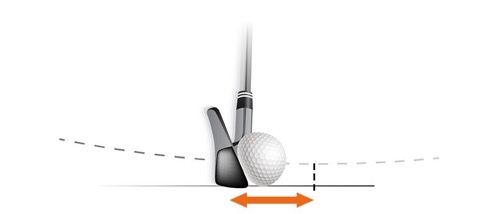
What is the correct Low Point
When the balls rests on the turf, it is necessary for golfers to hit down on the ball. This is because there is a need to strike the golf ball first and then the ground. In order to understand this think about the position of the divot after a well struck shot. It is always located on the target side of the golf ball. This signifies that the golfer’s club head is moving downwards through impact, it is a negative attack angle and a Low Point after the golf ball.
With a driver in hand, it is possible for the Low Point to be situated before the golf ball. The average angle of attack with a driver on the PGA Tour, as measured by Trackman, is -1.3 ̊ which implies the Low Point is after the ball. However, the average angle of attack on the LPGA Tour is +3 ̊, this means the Low Point is situated before the ball and the club head is travelling upwards through impact. Whatever the reasons behind this difference, be it technique, physical make-up or intention, this upward hit and Low Point position before the ball leads to a gain in potential distance. As an example, a golfer who swings at 90mph with a -5 ̊ angle of attack and makes a change that allows them to hit with a +5 ̊ angle of attack, could gain almost 30 yards in total distance. Golfers who reach the bottom of their swing arc before the ball and have their Low Point before the ball will need to consider the effect this has on the swing path as, all other things equal, this will tend to shift the club path to the left for a right hander. These golfers may therefore want to consider rotating their swing direction further to the right, or to the left for left handers, in order to compensate for this.
If we compare the average attack angle with a 7 iron on the PGA Tour with the same on the LPGA Tour, we notice that though both groups have the Low Point situated after the golf ball the women golfers don’t have the Low Point quite as far after the ball as the men. In fact, they hit down -2.3 ̊ with a 7 iron compared to -4.3 ̊ for the male golfers. The point to remember here is that though the Low Point must occur after the golf ball, there is in fact a reasonably wide range demonstrated by the world’s best players. Golfers with slower swing speeds may benefit by not having the Low Point situated too far after the golf ball as long as it remains after the golf ball.
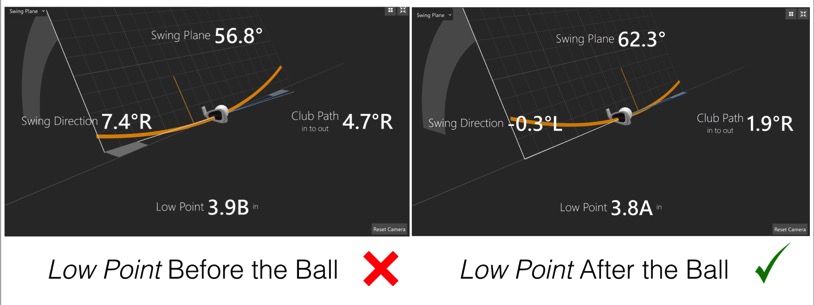
Low Point Patterns in Golfers of Different Abilities
It is important to note that the following are general patterns that I see day in and day out on the lesson tee. Of course, no two golfers are the same and each have their own individual swing tendencies. On a case by case basis, you can find golfers of different abilities who demonstrate every possible variable.
Pattern with a short to mid-iron from the fairway
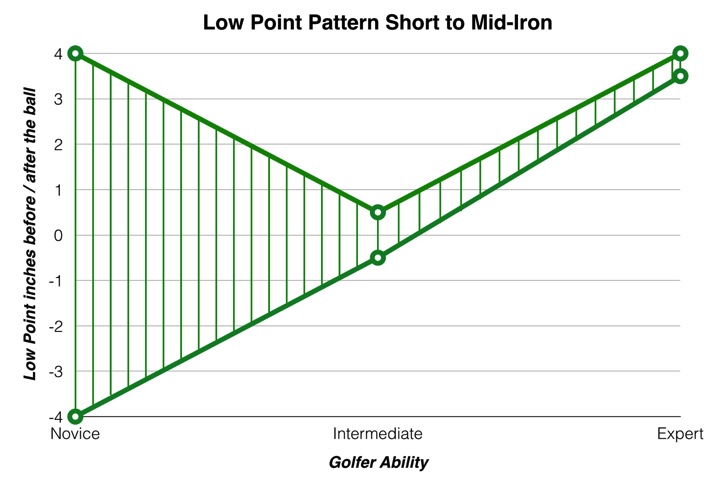
Novice Golfers Type 1 The Low Point is usually situated before the golf ball and there is a wide spread between shots. This means the club head reaches the bottom of its arc before impact and thus the club head is travelling upwards as the ball is struck. The consequence of this is that these golfers will tend to hit a number of fat and thin shots. They will generally hit thin shots when the arms flex too fast through impact, fat shots when the arms don’t flex fast enough and good shots when the arms flex just the right amount. This is a particularly chaotic procedure and makes it difficult to find any consistency in ball striking. These golfers will exhibit a flip through impact with a bending of the lead wrist as the club head overtakes the hands. These golfers are more comfortable when their ball rests sitting up on fluffy fairways or when the ball is teed up. The Dynamic loft will also tend to be too high for these golfers as they “add” loft to their club resulting in shots which reach their peak height too soon and lose distance as a consequence. Type 2 The Low Point is usually situated after the golf ball and there is a wide spread between shots. This is usually due to the fact these golfers have a severe over the top move during their downswings, the predominant trajectories are pulls and slices. These golfers will hit a number of fat and thin shots and exhibit the same tendencies through impact with the arms flexing and the club head overtaking the hands. As the club gets longer, the Low Point tends to move forwards rather than backwards as it should. These golfers normally hit their short clubs with too much loft and their longer clubs with not enough loft.
The following is an example of a Type 2 golfer changing his motion so that it is no longer over the top and shows the effect this move had on the Low Point of his swing:
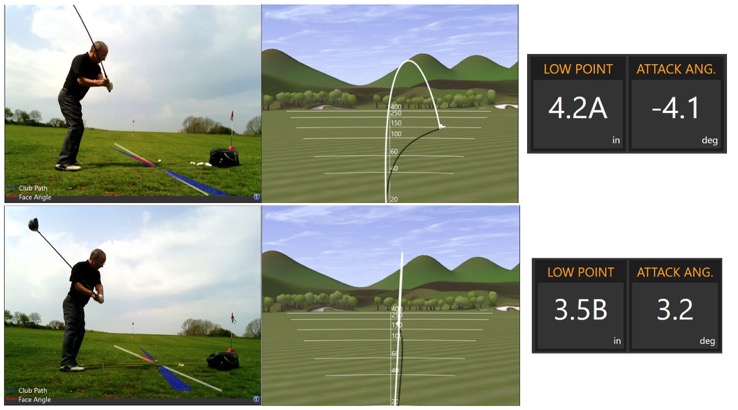
Intermediate Golfers
For these golfers the Low Point is often situated at the golf ball. This means the club head reaches the bottom of its arc during impact and thus the club head is travelling neither downwards or upwards. The Low Point varies from shot to shot but not as much as for novice golfers. These golfers will exhibit all the traits of the novice golfers but to a lesser degree. There will be some fat and thin shots and some loss of potential distance due to the loft delivered at impact even though the strikes are more solid and consistent.
Expert Golfers
In this instance the Low Point is situated after the golf ball and varies very little from shot to shot. This means the club head reaches the bottom of its arc after contact with the golf ball, as the club head is travelling downwards through impact. These players take their divots on the target side of their golf ball and their ball striking is solid with very few or no fat and thin shots. These golfers are comfortable hitting shots off tight fairways and even relish the opportunity of doing so. They exhibit a forward leaning shaft at impact with the club head trailing the hands. These players “reduce” the loft on their club, while not hitting down excessively, such that the golf ball is better compressed for golf shots that travel further.
Low Point Exercises
Knowledge of the Task at Hand
Make sure you have an understanding of the task. In order to become an accomplished ball striker when the ball rests on the ground, you must learn to hit the ball before the ground. This necessitates a descending angle of attack and a Low Point on the target side of the golf ball. On your next few shots, try and picture the Low Point of your swing on the target side of the golf ball rather than at the golf ball, this will help you create the forward leaning shaft and weight forwards configuration that is necessary to strike the ball well.
Punch Shots Hold the Finish Drill
First, mark a line on the ground using spray paint or make an indent in the ground by stepping on a dowel. Second, make some half swing practice swings where your club head makes a shallow dollar sized divot on the ground, starting on the line but not before it. To give yourself the best chance of accomplishing this, check that you finish with your arms straight, your hips forwards and your handle forwards. Second, introduce a golf ball and hit some punch shots following the same procedure. The ball should fly low and with a draw bias. Pay specific attention to your finish as it is a stationary position, thus making it possible to compare the motion you do from one shot to the next. For example you can check exactly how straight your arms are after each shot and make adjustments if needed. A good finish indicates many of the things that happened during the swing but were too fast to see were done well.
Notice in the sequence of pictures below, how clearly you can see the line on the ground as marked by the dowel. You can also observe how the hips and the shaft are forwards through impact which makes it possible to take the divot on the target side of the golf ball thus making the Low Point after the ball.

The Driver
As we have seen, having the Low Point situated slightly before the golf ball can be beneficial for hitting the ball longer distances with the driver. However, in my experience, the average golfer doesn’t have a strong enough “picture” in mind of what they are trying to achieve at impact. Quite often the Low Point is not situated sufficiently forwards because the golfer thinks he needs to assist the ball up into the air rather than let the club do the work. This is when golfers start to hang back, rather than transferring their weight forwards, and flip the wrists through impact while their arms flex, thus leading to all kinds of problems. More often than not, these moves have the opposite effect than that which is desired on the location of the Low Point. I often ask golfers what they think impact should look like and I am frequently told that it should mirror setup as closely as possible, this is not the case unless you have pre-set yourself into impact alignments before you start the swing. If you are going to work on having the Low Point slightly before the ball with a driver and an upwards angle of attack, make sure you don’t do it at the detriment of your basic impact alignments. Please ensure you achieve mastery of your Low Point by transferring your weight forwards via the motion of the hips going forwards, the body extending with the belt level rising and making an effort to keep the arms straight while the head remains centred and your inclination to the ground remaining constant. Remember also there are many things you can do to increase driver distance and altering your low point may or may not be the best option for you.
A Caveat
If the Low Point number given by Trackman indicates all is well but you are still struggling with fat and thin shots, be aware the distance between the lead shoulder and the golf ball must match the distance between the lead shoulder and the club head during impact. When this is not the case the golf ball still cannot be struck well.
Trackman measures a number called Low Point and learning to master the Low Point is an essential skill for golfers who want to make good contact with the ball and maximise their distance. The technical definition is that the Low Point represents the distance from the club head’s geometric centre to the lowest point on the swing arc at the time of maximum compression. Impact can occur either before the Low Point or after the Low Point has been reached by the club head. There is a strong correlation between Angle of Attack and Low Point as when the golfer hits down on the golf ball the Low Point is situated after the golf ball and when the golfer hits up on the golf ball the Low Point is situated before the golf ball. The illustrations below help to provide a clear understanding of the concept.
Low Point Illustration
The following picture depicts the arc the club head travels from approximately knee height on the downswing to knee height on the through swing with the bottom of the arc depicted here by a vertical white line. The lowest point on this arc is what is termed the Low Point. The ball is struck either before the club head reaches the low point with a descending angle of attack or after the club head reaches the low point with an upwards angle of attack.

In the picture below, you can see an example of the Low Point situated just after the golf ball as the club head travels downwards through impact. The vertical dotted line indicates the position of the Low Point and the orange arrow indicates the distance before the Low Point.
What is the correct Low Point
When the balls rests on the turf, it is necessary for golfers to hit down on the ball. This is because there is a need to strike the golf ball first and then the ground. In order to understand this think about the position of the divot after a well struck shot. It is always located on the target side of the golf ball. This signifies that the golfer’s club head is moving downwards through impact, it is a negative attack angle and a Low Point after the golf ball.
With a driver in hand, it is possible for the Low Point to be situated before the golf ball. The average angle of attack with a driver on the PGA Tour, as measured by Trackman, is -1.3 ̊ which implies the Low Point is after the ball. However, the average angle of attack on the LPGA Tour is +3 ̊, this means the Low Point is situated before the ball and the club head is travelling upwards through impact. Whatever the reasons behind this difference, be it technique, physical make-up or intention, this upward hit and Low Point position before the ball leads to a gain in potential distance. As an example, a golfer who swings at 90mph with a -5 ̊ angle of attack and makes a change that allows them to hit with a +5 ̊ angle of attack, could gain almost 30 yards in total distance. Golfers who reach the bottom of their swing arc before the ball and have their Low Point before the ball will need to consider the effect this has on the swing path as, all other things equal, this will tend to shift the club path to the left for a right hander. These golfers may therefore want to consider rotating their swing direction further to the right, or to the left for left handers, in order to compensate for this.
If we compare the average attack angle with a 7 iron on the PGA Tour with the same on the LPGA Tour, we notice that though both groups have the Low Point situated after the golf ball the women golfers don’t have the Low Point quite as far after the ball as the men. In fact, they hit down -2.3 ̊ with a 7 iron compared to -4.3 ̊ for the male golfers. The point to remember here is that though the Low Point must occur after the golf ball, there is in fact a reasonably wide range demonstrated by the world’s best players. Golfers with slower swing speeds may benefit by not having the Low Point situated too far after the golf ball as long as it remains after the golf ball.

Low Point Patterns in Golfers of Different Abilities
It is important to note that the following are general patterns that I see day in and day out on the lesson tee. Of course, no two golfers are the same and each have their own individual swing tendencies. On a case by case basis, you can find golfers of different abilities who demonstrate every possible variable.
Pattern with a short to mid-iron from the fairway

Novice Golfers Type 1 The Low Point is usually situated before the golf ball and there is a wide spread between shots. This means the club head reaches the bottom of its arc before impact and thus the club head is travelling upwards as the ball is struck. The consequence of this is that these golfers will tend to hit a number of fat and thin shots. They will generally hit thin shots when the arms flex too fast through impact, fat shots when the arms don’t flex fast enough and good shots when the arms flex just the right amount. This is a particularly chaotic procedure and makes it difficult to find any consistency in ball striking. These golfers will exhibit a flip through impact with a bending of the lead wrist as the club head overtakes the hands. These golfers are more comfortable when their ball rests sitting up on fluffy fairways or when the ball is teed up. The Dynamic loft will also tend to be too high for these golfers as they “add” loft to their club resulting in shots which reach their peak height too soon and lose distance as a consequence. Type 2 The Low Point is usually situated after the golf ball and there is a wide spread between shots. This is usually due to the fact these golfers have a severe over the top move during their downswings, the predominant trajectories are pulls and slices. These golfers will hit a number of fat and thin shots and exhibit the same tendencies through impact with the arms flexing and the club head overtaking the hands. As the club gets longer, the Low Point tends to move forwards rather than backwards as it should. These golfers normally hit their short clubs with too much loft and their longer clubs with not enough loft.
The following is an example of a Type 2 golfer changing his motion so that it is no longer over the top and shows the effect this move had on the Low Point of his swing:

Intermediate Golfers
For these golfers the Low Point is often situated at the golf ball. This means the club head reaches the bottom of its arc during impact and thus the club head is travelling neither downwards or upwards. The Low Point varies from shot to shot but not as much as for novice golfers. These golfers will exhibit all the traits of the novice golfers but to a lesser degree. There will be some fat and thin shots and some loss of potential distance due to the loft delivered at impact even though the strikes are more solid and consistent.
Expert Golfers
In this instance the Low Point is situated after the golf ball and varies very little from shot to shot. This means the club head reaches the bottom of its arc after contact with the golf ball, as the club head is travelling downwards through impact. These players take their divots on the target side of their golf ball and their ball striking is solid with very few or no fat and thin shots. These golfers are comfortable hitting shots off tight fairways and even relish the opportunity of doing so. They exhibit a forward leaning shaft at impact with the club head trailing the hands. These players “reduce” the loft on their club, while not hitting down excessively, such that the golf ball is better compressed for golf shots that travel further.
Low Point Exercises
Knowledge of the Task at Hand
Make sure you have an understanding of the task. In order to become an accomplished ball striker when the ball rests on the ground, you must learn to hit the ball before the ground. This necessitates a descending angle of attack and a Low Point on the target side of the golf ball. On your next few shots, try and picture the Low Point of your swing on the target side of the golf ball rather than at the golf ball, this will help you create the forward leaning shaft and weight forwards configuration that is necessary to strike the ball well.
Punch Shots Hold the Finish Drill
First, mark a line on the ground using spray paint or make an indent in the ground by stepping on a dowel. Second, make some half swing practice swings where your club head makes a shallow dollar sized divot on the ground, starting on the line but not before it. To give yourself the best chance of accomplishing this, check that you finish with your arms straight, your hips forwards and your handle forwards. Second, introduce a golf ball and hit some punch shots following the same procedure. The ball should fly low and with a draw bias. Pay specific attention to your finish as it is a stationary position, thus making it possible to compare the motion you do from one shot to the next. For example you can check exactly how straight your arms are after each shot and make adjustments if needed. A good finish indicates many of the things that happened during the swing but were too fast to see were done well.
Notice in the sequence of pictures below, how clearly you can see the line on the ground as marked by the dowel. You can also observe how the hips and the shaft are forwards through impact which makes it possible to take the divot on the target side of the golf ball thus making the Low Point after the ball.

The Driver
As we have seen, having the Low Point situated slightly before the golf ball can be beneficial for hitting the ball longer distances with the driver. However, in my experience, the average golfer doesn’t have a strong enough “picture” in mind of what they are trying to achieve at impact. Quite often the Low Point is not situated sufficiently forwards because the golfer thinks he needs to assist the ball up into the air rather than let the club do the work. This is when golfers start to hang back, rather than transferring their weight forwards, and flip the wrists through impact while their arms flex, thus leading to all kinds of problems. More often than not, these moves have the opposite effect than that which is desired on the location of the Low Point. I often ask golfers what they think impact should look like and I am frequently told that it should mirror setup as closely as possible, this is not the case unless you have pre-set yourself into impact alignments before you start the swing. If you are going to work on having the Low Point slightly before the ball with a driver and an upwards angle of attack, make sure you don’t do it at the detriment of your basic impact alignments. Please ensure you achieve mastery of your Low Point by transferring your weight forwards via the motion of the hips going forwards, the body extending with the belt level rising and making an effort to keep the arms straight while the head remains centred and your inclination to the ground remaining constant. Remember also there are many things you can do to increase driver distance and altering your low point may or may not be the best option for you.
A Caveat
If the Low Point number given by Trackman indicates all is well but you are still struggling with fat and thin shots, be aware the distance between the lead shoulder and the golf ball must match the distance between the lead shoulder and the club head during impact. When this is not the case the golf ball still cannot be struck well.
Learning - Maximise Your Lesson Benefits
14/11/14 11:10
The first thing you need to know is that you need to have the correct conception of what a golf swing is in your mind in order for you to be able to play the game successfully. Your brain tells your body what to do, your body makes the golf club move and the golf club dictates to the ball how it will travel. Hence, whatever the result of the shot you have just hit, the underlying cause can be traced back to your brain.
When a beginner takes up the game, they usually already have an idea formed in their mind of how a golf swing operates and what they need to do to strike the ball. The idea in their mind, however, is often rough around the edges and more often than not incorrect. The golfer’s goal as they seek to develop must be to add more and more sophistication to their understanding of the motor skill they are trying to perform.
Here are a few key points I think everybody must reflect on regarding the lesson process
Before the lesson
Be aware of the fact you will need to work hard to improve. If like most people you don’t have the time or opportunity to play much golf be prepared to have to take baby steps and to consider your improvement as a long-term project. You are the person in command, Homer Kelley says that the instructor can inform and explain but it is the pupil’s job to absorb and apply.
In order to change your ball flight you will need to change the way in which you deliver the clubhead to the ball. This means you will need to change the way you think about the swing and means you will be creating a change in your habitual motion. Any change in your motion is going to create a change in feel. The trick is to think of this as something you expect to happen and as something new rather than as something odd and uncomfortable.
During the lesson
Don’t take your instructors word for it. Make sure what he is saying and asking of you makes sense in your mind and that you understand why you are trying to perform a certain move. It’s very hard to commit and follow through with something that you do not understand. Furthermore it is even harder to evaluate how you are progressing if you don’t truly understand what it is that you are working on. In this regard, a camera is an invaluable tool in tracking progress and changes that you make over time.
Understand that until the time when you break it down into the smallest minute details there really is only one golf swing. As a result do not be surprised when your instructor perhaps makes you work with an iron rather than with your driver. The instructor sees the same fault with both clubs but you are simply getting less reward for your efforts with the longer club.
After the lesson
Practice time is invaluable and it must take place on the golf course and on the range, working on all aspects of the game.
Think of those players who are better players than you as being more skilled, not more talented. Skill comes from a better understanding, obtaining reliable feedback and hard work.
Finally, and most important, enjoy the process and embrace both its ups and downs.
When a beginner takes up the game, they usually already have an idea formed in their mind of how a golf swing operates and what they need to do to strike the ball. The idea in their mind, however, is often rough around the edges and more often than not incorrect. The golfer’s goal as they seek to develop must be to add more and more sophistication to their understanding of the motor skill they are trying to perform.
Here are a few key points I think everybody must reflect on regarding the lesson process
Before the lesson
Be aware of the fact you will need to work hard to improve. If like most people you don’t have the time or opportunity to play much golf be prepared to have to take baby steps and to consider your improvement as a long-term project. You are the person in command, Homer Kelley says that the instructor can inform and explain but it is the pupil’s job to absorb and apply.
In order to change your ball flight you will need to change the way in which you deliver the clubhead to the ball. This means you will need to change the way you think about the swing and means you will be creating a change in your habitual motion. Any change in your motion is going to create a change in feel. The trick is to think of this as something you expect to happen and as something new rather than as something odd and uncomfortable.
During the lesson
Don’t take your instructors word for it. Make sure what he is saying and asking of you makes sense in your mind and that you understand why you are trying to perform a certain move. It’s very hard to commit and follow through with something that you do not understand. Furthermore it is even harder to evaluate how you are progressing if you don’t truly understand what it is that you are working on. In this regard, a camera is an invaluable tool in tracking progress and changes that you make over time.
Understand that until the time when you break it down into the smallest minute details there really is only one golf swing. As a result do not be surprised when your instructor perhaps makes you work with an iron rather than with your driver. The instructor sees the same fault with both clubs but you are simply getting less reward for your efforts with the longer club.
After the lesson
Practice time is invaluable and it must take place on the golf course and on the range, working on all aspects of the game.
Think of those players who are better players than you as being more skilled, not more talented. Skill comes from a better understanding, obtaining reliable feedback and hard work.
Finally, and most important, enjoy the process and embrace both its ups and downs.
Paradigm Shift?
14/11/14 11:05
Is a Paradigm Shift occurring in the world of golf instruction?
To answer this question we first need to define the term “paradigm shift” and explain where it comes from. American philosopher of science Thomas Kuhn coined the term Paradigm Shift in his 1962 publication titled “The Structure of Scientific Revolutions”. His conclusion was that progress in science occurs in the form of “paradigm shifts” rather than as a continual and gradual process. He rejected the notion that all scientific processes and belief systems are equal. He also stated that when a paradigm shit occurs the new paradigm is not only newer but also improves the previous one.
Now lets examine just a few of the well rehearsed clichés within golf instruction circles that often do more harm than good or at the very least slow down the learning process for the pupil.
Myth #1. The clubpath dictates the initial starting direction of the golf ball
In fact it is predominantly the clubface that dictates the direction in which the golf ball launches. This directly contradicts the notion that players should swing in the direction they would like the ball to start and aim the clubface where they would like the ball to finish. This knowledge is essential for making a correct diagnosis of possible faults affecting impact position and learning how to hit shots with different trajectories. Imagine a golfer wanting to hit a draw, for a right-handed golfer this is a shot that starts to the right of the target and then curves back towards the target. Assuming centre contact, the clubface will need to be pointing to the right of the target at impact for the ball to start to the right and the path will have to be more to the right than the amount the clubface is pointing to the right. If the clubface is pointed to the left of the target or even at the target at the moment of impact it will not be possible to hit a draw shot. Remember, the clubface is the projection tool.
Myth #2. The fundamentals are aim, grip, stance, alignment and ball position
While these are undoubtedly very important and will have a big effect on the way the golf ball is projected, they are not factors that the world’s best golfers demonstrate uniformly. This implies that they are variables. A fundamental is something that all of the world’s best players demonstrate equally. The lowest common denominator that they possess is their ability to hit the ground in the same spot, time after time, on the target side of the golf ball. In other words, hit the small ball before the big ball! This should be the first priority for the average golfer seeking to improve. Huge strides can be made once a pupil learns how to make solid ball contact.
Myth #3. All players are the same at impact
The reality is that not even the best golfers can replicate the exact same impact conditions time after time. Every shot is slightly different to the one before it and also to the one after. What players do demonstrate, however, are set patterns and relationships that they repeat on a regular basis (for example a face that is closed to the path).
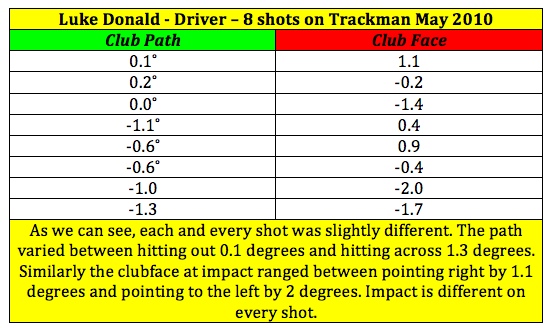
Myth #4. Roll your forearms to hit a draw
This stems from the belief that the golfer needs to close the face for the moment of impact. Unfortunately, as we have just outlined, a face that is closed to the target at impact is not conducive to hitting a draw shot. Furthermore, rolling the forearms approaching impact has the effect of sending the clubhead to the outside and above the plane thus leading to an out/in swing path and a handle that is lowering and leaning away from the target at impact. The very opposite of what a golfer needs to do hit the ball solidly (let alone draw the ball!).
Myth #5. Keep the rear leg bent and the golf swing is like a spring
It is often said that the rear leg should remain flexed during the course of the backswing and that the upper body should turn while the hips and lower body resist this turning action. The upper body coiling against the lower body resistance is described as a spring. The effect of all this is that the shoulder complex will have a limited range of motion. Consequently some golfers will start to flex and raise their arms in order to complete their backswings and others will simply make very short backswings. Both of these scenarios are detrimental to hitting the ball solidly, far and high. If, however, golfers allow their trail leg to straighten during the backswing this will allow the hips to turn which will allow the shoulders to turn. The golfer is now loading the catapult and a very achievable 45˚ hip turn combined with a very achievable 45˚ shoulder turn make for a full 90˚ turn at the top of the backswing. A whole industry has fed off telling golfers that they are not flexible enough to play golf as a consequence of this damaging advice. A golf swing that hits the ball consistently, far enough and with a predictable curve is not beyond the scope of the average golfer.
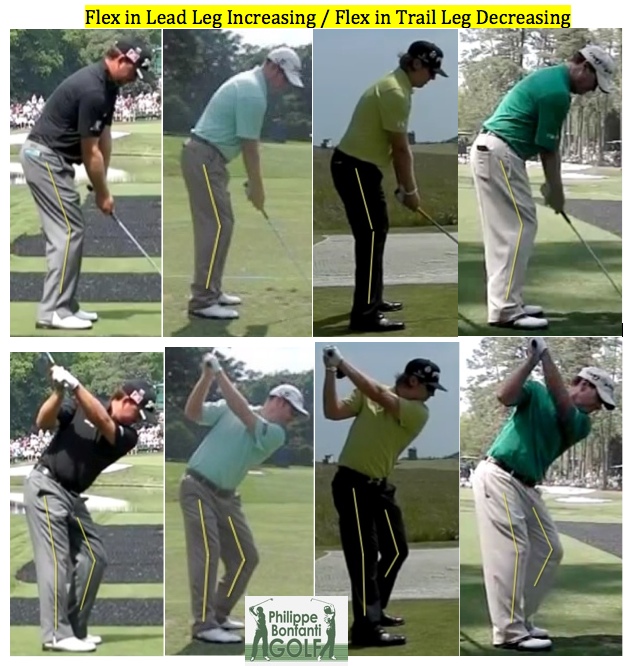
Myth #6. Maintain your spine angle
What is often referred to as maintaining the spine angle is actually about the golfer’s inclination to the ground. This must be maintained to keep the head stationary. In order for a player to maintain their inclination to the ground the spine will need to constantly change its angle. For a right-hander it will turn but it will also move from a left tilt to a right tilt and it will extend-flex-extend.
Myth #7. Shift your weight over your back foot to generate power
This advice is given in accordance with the misplaced idea that you need to “load” your weight into your trail leg in order to generate power. The reality is that one of the major power sources in the golf swing is first and foremost the ability to strike the golf ball solidly (fat shots tend not to go very far!). Shifting the weight to the back foot necessitates at the very least an equal sway back to the front foot thus making it very difficult to time and increasing the probability of the clubhead’s arc bottoming out before the golf ball has been reached. To generate power golfers must concentrate their efforts on hitting the ball solidly, using the body as a lever as it side tilts and moves from flexion to extension, and on swinging the clubhead on a tilted angle around the body (think depth not width).
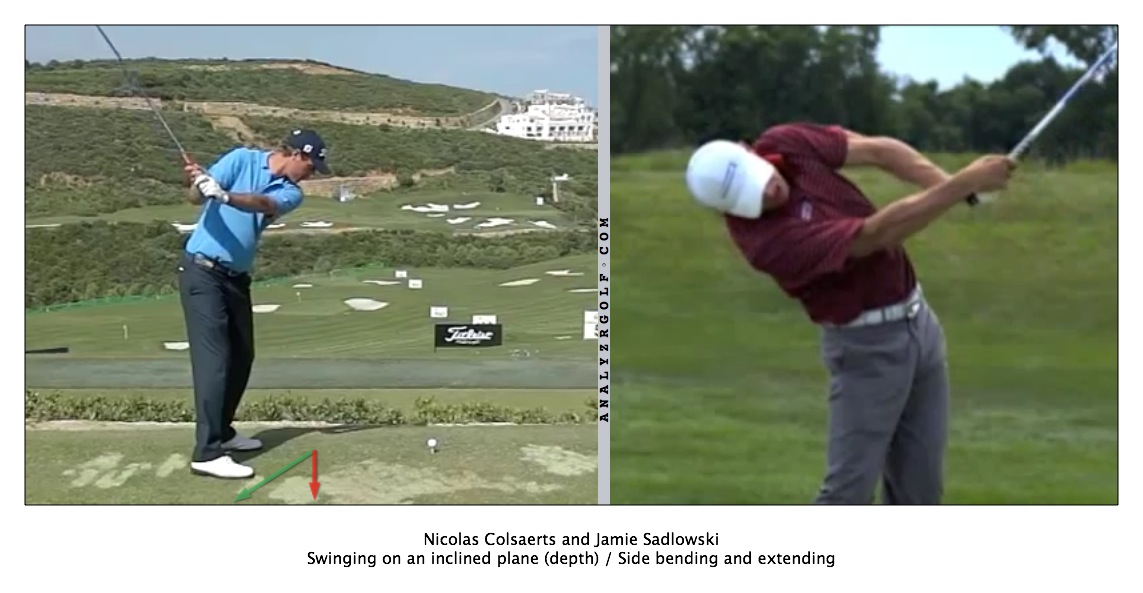
As we have seen, some of the most recognisable and often repeated buzzwords heard on practice tees around the world can be misleading. Here is just a small sample of quotes from some of the world’s leading instructors and tour players on how to swing a golf club from the last ten years followed by some more recent quotes
Old Quotes:
“I will keep my right knee flex”
“square the face at impact”
“flex your knee for big hits”
“power comes from the hips rotating less than the upper body on the backswing”
“give the ball a right hand slap for explosive contact”
“you can tell the good players from the bad players by looking at their grip”
“get wide, stay wide”
“bad position is left shoulder down”
“to fix your slicing, use the left arm to square up the face at impact”
Recent Quotes (2011-2012):
“keep as much weight forwards as possible while keeping your head centred”
“round your swing and produce shots you’ve only dreamed of”
“shift your hips and lead with your hands for great contact”
“the bottom of the swing, where the club hits the ground, is a few inches in front of the ball”
“the biggest mistake amateurs make is hitting off their back foot”
“ideally, your hips turn away from the target as much as they can”
“if you look at Nick Faldo which shoulder is lower? The left shoulder is lower at the top of the backswing, so actually he’s leaning left”
“I try to stay centred as I swing back, not letting my head move to the right. Staying over the ball allows me to turn my left shoulder downward on a steeper angle”
It does appear that the message delivered by golf instructors all over the world is gradually changing as more information becomes available. This can only be a good thing for the average golfer who dearly wants to improve his or her golf game. Kuhn states: “Successive transition from one paradigm to another via revolution is the usual developmental pattern of mature science”. Almost inevitably, a few feathers have been ruffled along this fast paced journey of discovery. The overriding objective for all instructors, however, should be to remain passionate about their work and to do their utmost to help their students improve, irrespective of the extent to which new ideas challenge long held beliefs and methods. In the words of a wise instructor, the goal for all of us should be to “keep the spirit of the game alive” not in a manner of confrontation but rather in a manner of cooperation for the good of the sport we all love.
To answer this question we first need to define the term “paradigm shift” and explain where it comes from. American philosopher of science Thomas Kuhn coined the term Paradigm Shift in his 1962 publication titled “The Structure of Scientific Revolutions”. His conclusion was that progress in science occurs in the form of “paradigm shifts” rather than as a continual and gradual process. He rejected the notion that all scientific processes and belief systems are equal. He also stated that when a paradigm shit occurs the new paradigm is not only newer but also improves the previous one.
Now lets examine just a few of the well rehearsed clichés within golf instruction circles that often do more harm than good or at the very least slow down the learning process for the pupil.
Myth #1. The clubpath dictates the initial starting direction of the golf ball
In fact it is predominantly the clubface that dictates the direction in which the golf ball launches. This directly contradicts the notion that players should swing in the direction they would like the ball to start and aim the clubface where they would like the ball to finish. This knowledge is essential for making a correct diagnosis of possible faults affecting impact position and learning how to hit shots with different trajectories. Imagine a golfer wanting to hit a draw, for a right-handed golfer this is a shot that starts to the right of the target and then curves back towards the target. Assuming centre contact, the clubface will need to be pointing to the right of the target at impact for the ball to start to the right and the path will have to be more to the right than the amount the clubface is pointing to the right. If the clubface is pointed to the left of the target or even at the target at the moment of impact it will not be possible to hit a draw shot. Remember, the clubface is the projection tool.
Myth #2. The fundamentals are aim, grip, stance, alignment and ball position
While these are undoubtedly very important and will have a big effect on the way the golf ball is projected, they are not factors that the world’s best golfers demonstrate uniformly. This implies that they are variables. A fundamental is something that all of the world’s best players demonstrate equally. The lowest common denominator that they possess is their ability to hit the ground in the same spot, time after time, on the target side of the golf ball. In other words, hit the small ball before the big ball! This should be the first priority for the average golfer seeking to improve. Huge strides can be made once a pupil learns how to make solid ball contact.
Myth #3. All players are the same at impact
The reality is that not even the best golfers can replicate the exact same impact conditions time after time. Every shot is slightly different to the one before it and also to the one after. What players do demonstrate, however, are set patterns and relationships that they repeat on a regular basis (for example a face that is closed to the path).

Myth #4. Roll your forearms to hit a draw
This stems from the belief that the golfer needs to close the face for the moment of impact. Unfortunately, as we have just outlined, a face that is closed to the target at impact is not conducive to hitting a draw shot. Furthermore, rolling the forearms approaching impact has the effect of sending the clubhead to the outside and above the plane thus leading to an out/in swing path and a handle that is lowering and leaning away from the target at impact. The very opposite of what a golfer needs to do hit the ball solidly (let alone draw the ball!).
Myth #5. Keep the rear leg bent and the golf swing is like a spring
It is often said that the rear leg should remain flexed during the course of the backswing and that the upper body should turn while the hips and lower body resist this turning action. The upper body coiling against the lower body resistance is described as a spring. The effect of all this is that the shoulder complex will have a limited range of motion. Consequently some golfers will start to flex and raise their arms in order to complete their backswings and others will simply make very short backswings. Both of these scenarios are detrimental to hitting the ball solidly, far and high. If, however, golfers allow their trail leg to straighten during the backswing this will allow the hips to turn which will allow the shoulders to turn. The golfer is now loading the catapult and a very achievable 45˚ hip turn combined with a very achievable 45˚ shoulder turn make for a full 90˚ turn at the top of the backswing. A whole industry has fed off telling golfers that they are not flexible enough to play golf as a consequence of this damaging advice. A golf swing that hits the ball consistently, far enough and with a predictable curve is not beyond the scope of the average golfer.

Myth #6. Maintain your spine angle
What is often referred to as maintaining the spine angle is actually about the golfer’s inclination to the ground. This must be maintained to keep the head stationary. In order for a player to maintain their inclination to the ground the spine will need to constantly change its angle. For a right-hander it will turn but it will also move from a left tilt to a right tilt and it will extend-flex-extend.
Myth #7. Shift your weight over your back foot to generate power
This advice is given in accordance with the misplaced idea that you need to “load” your weight into your trail leg in order to generate power. The reality is that one of the major power sources in the golf swing is first and foremost the ability to strike the golf ball solidly (fat shots tend not to go very far!). Shifting the weight to the back foot necessitates at the very least an equal sway back to the front foot thus making it very difficult to time and increasing the probability of the clubhead’s arc bottoming out before the golf ball has been reached. To generate power golfers must concentrate their efforts on hitting the ball solidly, using the body as a lever as it side tilts and moves from flexion to extension, and on swinging the clubhead on a tilted angle around the body (think depth not width).

As we have seen, some of the most recognisable and often repeated buzzwords heard on practice tees around the world can be misleading. Here is just a small sample of quotes from some of the world’s leading instructors and tour players on how to swing a golf club from the last ten years followed by some more recent quotes
Old Quotes:
“I will keep my right knee flex”
“square the face at impact”
“flex your knee for big hits”
“power comes from the hips rotating less than the upper body on the backswing”
“give the ball a right hand slap for explosive contact”
“you can tell the good players from the bad players by looking at their grip”
“get wide, stay wide”
“bad position is left shoulder down”
“to fix your slicing, use the left arm to square up the face at impact”
Recent Quotes (2011-2012):
“keep as much weight forwards as possible while keeping your head centred”
“round your swing and produce shots you’ve only dreamed of”
“shift your hips and lead with your hands for great contact”
“the bottom of the swing, where the club hits the ground, is a few inches in front of the ball”
“the biggest mistake amateurs make is hitting off their back foot”
“ideally, your hips turn away from the target as much as they can”
“if you look at Nick Faldo which shoulder is lower? The left shoulder is lower at the top of the backswing, so actually he’s leaning left”
“I try to stay centred as I swing back, not letting my head move to the right. Staying over the ball allows me to turn my left shoulder downward on a steeper angle”
It does appear that the message delivered by golf instructors all over the world is gradually changing as more information becomes available. This can only be a good thing for the average golfer who dearly wants to improve his or her golf game. Kuhn states: “Successive transition from one paradigm to another via revolution is the usual developmental pattern of mature science”. Almost inevitably, a few feathers have been ruffled along this fast paced journey of discovery. The overriding objective for all instructors, however, should be to remain passionate about their work and to do their utmost to help their students improve, irrespective of the extent to which new ideas challenge long held beliefs and methods. In the words of a wise instructor, the goal for all of us should be to “keep the spirit of the game alive” not in a manner of confrontation but rather in a manner of cooperation for the good of the sport we all love.
Recipe for Success
14/11/14 11:04
Some of you may be interested in these brief notes on what is required for you to reach the top and become an elite golfer:
1. Practice with purpose
2. Have the right training system and coach
3. Have a systematic approach that enables you to receive feedback on the things you do
4. A high level of motivation
5. Be given praise for your hard work
6. Have self belief and possibly even irrational optimism
7. Experience is important. Intuition and instincts are learned skills that stem from experience. They are what enable automaticity. Every wrong attempt that you can eliminate is a further step forward.
Carol Dweck, a Psychology professor at Stanford University states:
“The hand you’re dealt is just a starting point…although people may differ in every which way - in their initial talents and aptitudes, interests or temperaments - anyone can grow through application and experience… In a growth mindset students understand that their talents and abilities can be developed through effort, good teaching and persistence. They don’t necessarily think everyone’s the same or everyone can be Einstein, but they believe everyone can get smarter if they work at it.”
Susan Polgar, the first female chess Grandmaster states:
“I really believe that if you put your mind to it and you really want it, you can achieve it, whatever it is…the work part, the diligence part, is the most important…and I think that being trained properly anybody can achieve practically anything.”
Are you prepared and raring to go? I know I am!
1. Practice with purpose
2. Have the right training system and coach
3. Have a systematic approach that enables you to receive feedback on the things you do
4. A high level of motivation
5. Be given praise for your hard work
6. Have self belief and possibly even irrational optimism
7. Experience is important. Intuition and instincts are learned skills that stem from experience. They are what enable automaticity. Every wrong attempt that you can eliminate is a further step forward.
Carol Dweck, a Psychology professor at Stanford University states:
“The hand you’re dealt is just a starting point…although people may differ in every which way - in their initial talents and aptitudes, interests or temperaments - anyone can grow through application and experience… In a growth mindset students understand that their talents and abilities can be developed through effort, good teaching and persistence. They don’t necessarily think everyone’s the same or everyone can be Einstein, but they believe everyone can get smarter if they work at it.”
Susan Polgar, the first female chess Grandmaster states:
“I really believe that if you put your mind to it and you really want it, you can achieve it, whatever it is…the work part, the diligence part, is the most important…and I think that being trained properly anybody can achieve practically anything.”
Are you prepared and raring to go? I know I am!
Raising the Belt
14/11/14 11:01
In the left photo, we can see that at address, this golfer’s spine is approximately vertical, perpendicular to the ground.
In the right photo, we see that as he reaches the top of his backswing, his spine has tilted left approximately 35 degrees.
We are watching the swing from two different angles to measure the same thing because as the golfer’s hips and shoulder complex turn, the golfer’s orientation moves from the back facing the left rough to the back facing the target.
This change in spine angle is a side tilt to the left, combined with extension and turn it allows the golfer to keep the head centred.
Keeping the shoulder centre stable enables the club to return to the ball in a consistent manner (low point control).
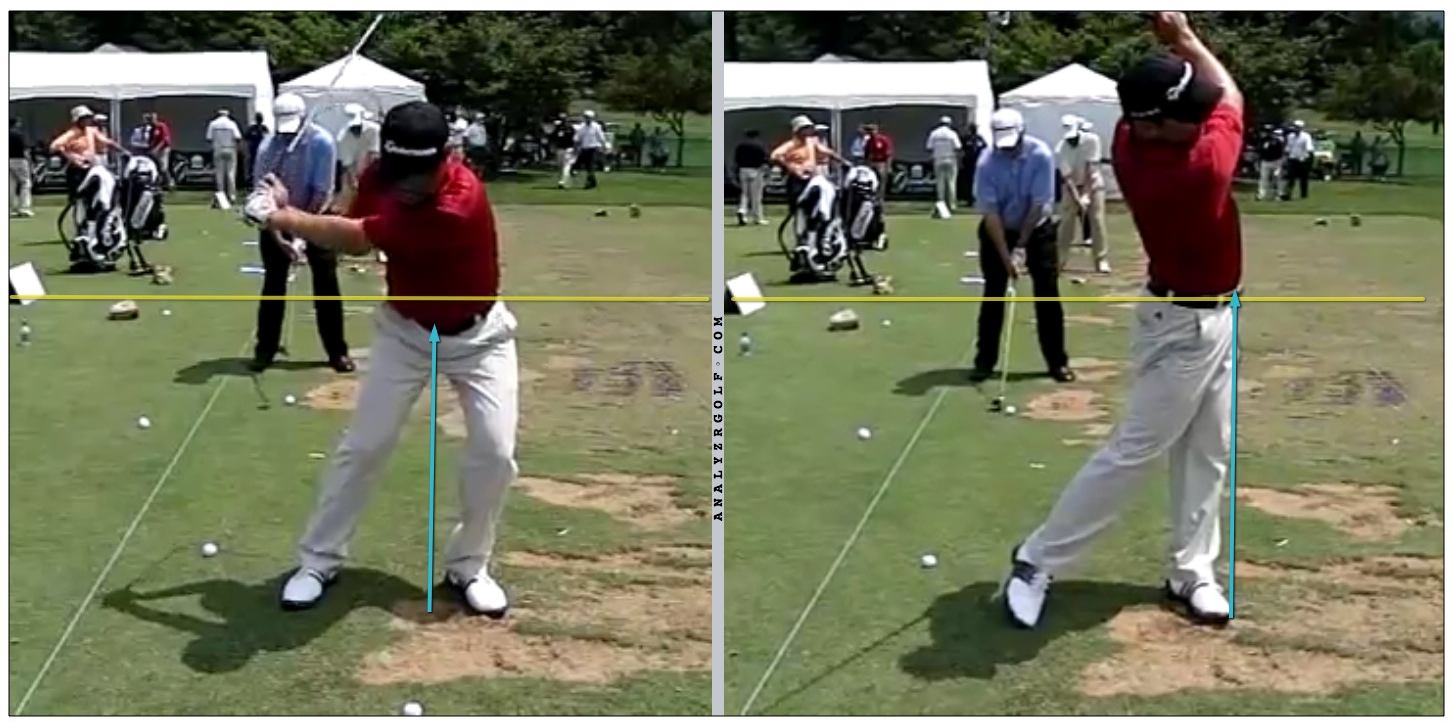
In the right photo, we see that as he reaches the top of his backswing, his spine has tilted left approximately 35 degrees.
We are watching the swing from two different angles to measure the same thing because as the golfer’s hips and shoulder complex turn, the golfer’s orientation moves from the back facing the left rough to the back facing the target.
This change in spine angle is a side tilt to the left, combined with extension and turn it allows the golfer to keep the head centred.
Keeping the shoulder centre stable enables the club to return to the ball in a consistent manner (low point control).

Side Tilt - What is it?
14/11/14 10:44
In the left photo, we can see that at address, this golfer’s spine is approximately vertical, perpendicular to the ground.
In the right photo, we see that as he reaches the top of his backswing, his spine has tilted left approximately 35 degrees.
We are watching the swing from two different angles to measure the same thing because as the golfer’s hips and shoulder complex turn, the golfer’s orientation moves from the back facing the left rough to the back facing the target.
This change in spine angle is a side tilt to the left, combined with extension and turn it allows the golfer to keep the head centred.
Keeping the shoulder centre stable enables the club to return to the ball in a consistent manner (low point control).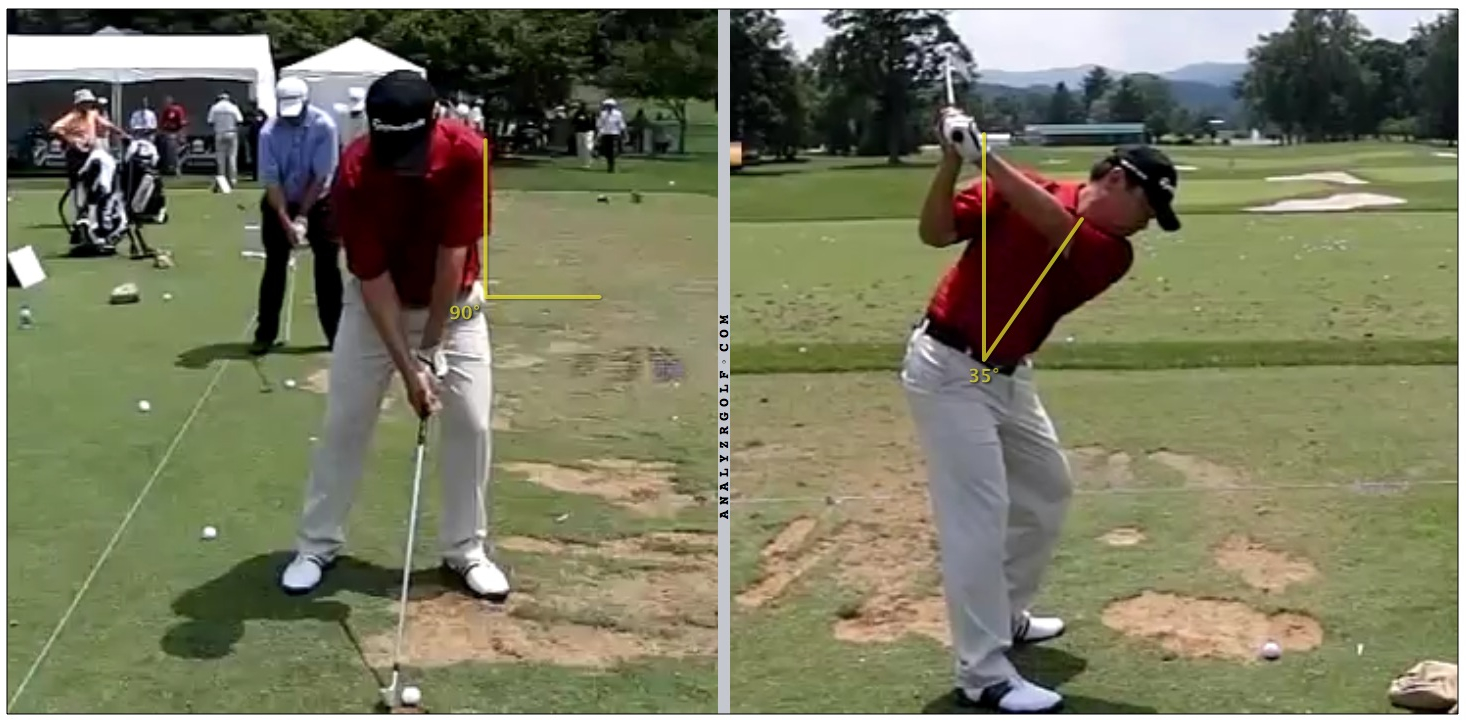
In the right photo, we see that as he reaches the top of his backswing, his spine has tilted left approximately 35 degrees.
We are watching the swing from two different angles to measure the same thing because as the golfer’s hips and shoulder complex turn, the golfer’s orientation moves from the back facing the left rough to the back facing the target.
This change in spine angle is a side tilt to the left, combined with extension and turn it allows the golfer to keep the head centred.
Keeping the shoulder centre stable enables the club to return to the ball in a consistent manner (low point control).

Positive Thinking
31/10/14 15:15
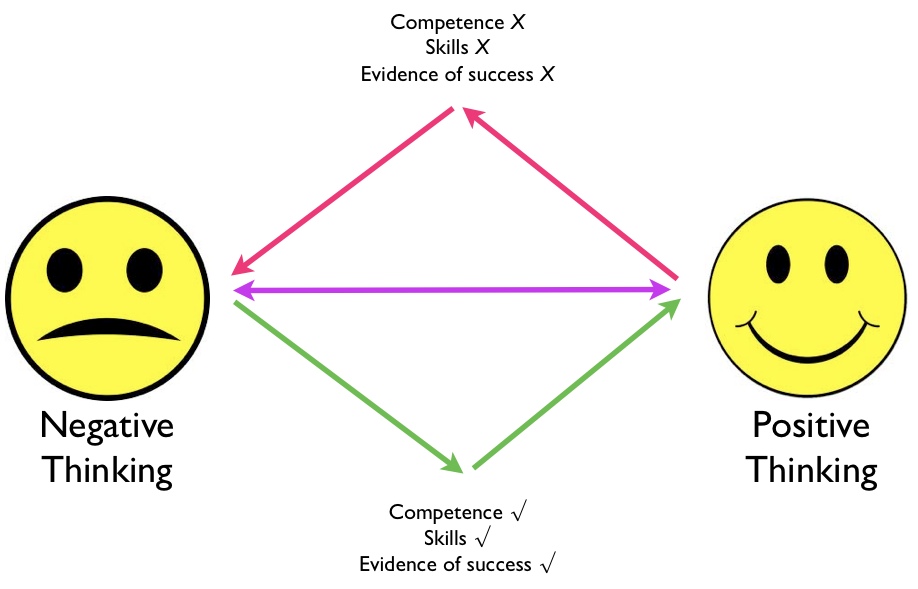 The theory:
The theory:There are many references in golf literature extolling the benefits of positive thinking. The belief is that you can combat your negative thoughts and replace them with positive thoughts. This serves to reduce anxiety, promote higher levels of self-confidence and therefore improve performance levels.
The situation:
You are standing on the tee with a driver in hand, the fairway ahead of you seems narrow and far away. You need to win this hole in order to have a chance of winning your match. Not to worry, you have been doing your positive thinking exercises and you are now ready to tee off.
The shot outcome:
Unfortunately you slice your drive into the trees and there is a good chance you won’t be able to find the ball, let alone play a recovery shot to put yourself back in position.
What happened:
Your mind is now presented with a contradiction between your expected result and your actual result. Your mind knows that you weren’t being honest with your positive assessment. You could visualise driving off that hole in the most vivid detail 100 times and never fail to hit a good tee shot but your belief would not be grounded in reality. You need evidence that you are able to achieve something successfully before you can think about it positively. This means you must have a solid foundation of core skills that enable you to complete the required task. As the saying goes, competence breeds confidence, not vice-versa.
What next:
It is counter productive to keep telling yourself you excel at something when all evidence you have is to the contrary. If you are keen to improve, ask yourself:
“What must I change and work on in order to improve my results?”
Learning From the Greats
31/10/14 15:13
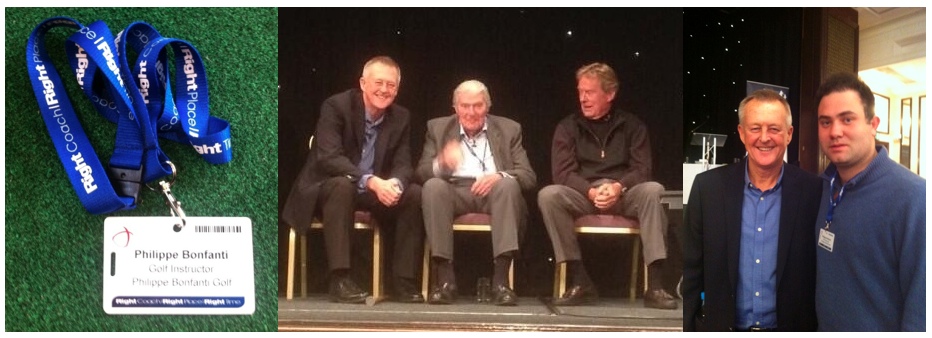 I have just returned from a coaching conference where the guest speakers were Martin Hall and Jim Hardy. They both did presentations on the topic of teaching the recreational Golfer. Martin Hall is currently ranked 7th in Golf Digest’s list of the Top 50 instructors in America and presents School of Golf on the Golf Channel. Jim hardy is ranked 8th in Golf Digest’s list of Top instructors in America and currently works with 19 Tour Players. He is perhaps best known for his One Plane and Two Plane swing models.
I have just returned from a coaching conference where the guest speakers were Martin Hall and Jim Hardy. They both did presentations on the topic of teaching the recreational Golfer. Martin Hall is currently ranked 7th in Golf Digest’s list of the Top 50 instructors in America and presents School of Golf on the Golf Channel. Jim hardy is ranked 8th in Golf Digest’s list of Top instructors in America and currently works with 19 Tour Players. He is perhaps best known for his One Plane and Two Plane swing models. Having the chance to listen to the people at the top of our profession is always an honour and I feel there is always something to be learned. Martin Hall emphasised this throughout his talk stating that you should always search for evidence that counters your beliefs and try to entertain hypotheses that are antagonistic to one another. I often say to people that if they do one thing differently following a lesson then it has been worth their while. This certainly applies here and I will try and share with you some of the important messages that I feel were emphasised on the day.
Both of them heavily emphasised the importance of ball contact with Martin stating, “I teach ball contact first” and Jim stating, “the priority is solid contact”. This is the first thing that must be mastered in order to play good golf. A golfer who hits it solid will have much more enjoyment from the game than someone who struggles to make contact. Jim spoke about the fact that in order to achieve this you must control your swing bottom, in other words you must control the the low point of your golf swing. Methods discussed to improve this were to look out for elements in a swing that contribute to a steep angle of hit and elements that contribute to a shallow angle of hit with the aim of balancing them out against one another. One of Martin’s strengths is his ability to “invent” tools to convey his messages. For low point control he uses all manner of contraptions such as ropes, spray paint cans, hammers, sponges and a club with zero loft. I feel this helps tremendously with keeping things informative but also fun.
Emphasis was also placed on the need to help the golfer immediately. I am a strong believer in this and have never understood those who say that you must take a step backwards before you take two steps forwards. It should not take more than 15 minutes or so to change your ball flight during a lesson and if you take a step backwards you are prioritising a change in the wrong piece.
Several times throughout his presentation Martin followed up a point he was making by saying “I don’t know if that’s true, but I know it helps in my teaching”. This is so important because teaching isn’t simply about dispensing information; it is also about building trust and relationships. I have heard my friend Andy Plummer say this many times “the goal isn’t to be the smartest person in the room but to help the most golfers.”
The day was concluded with a question and answer session with the legendary John Jacobs who many of today’s leading instructors look to as a mentor. His passion for the game, even at the age of 88, was overwhelming.
The final thoughts I’m taking home with me are that “if the only tool you have is a hammer, everything looks like a nail” and that “fix” is a positive word. We must all keep learning and improving, “Remind yourself you’ve got to do better at everything you do”.
